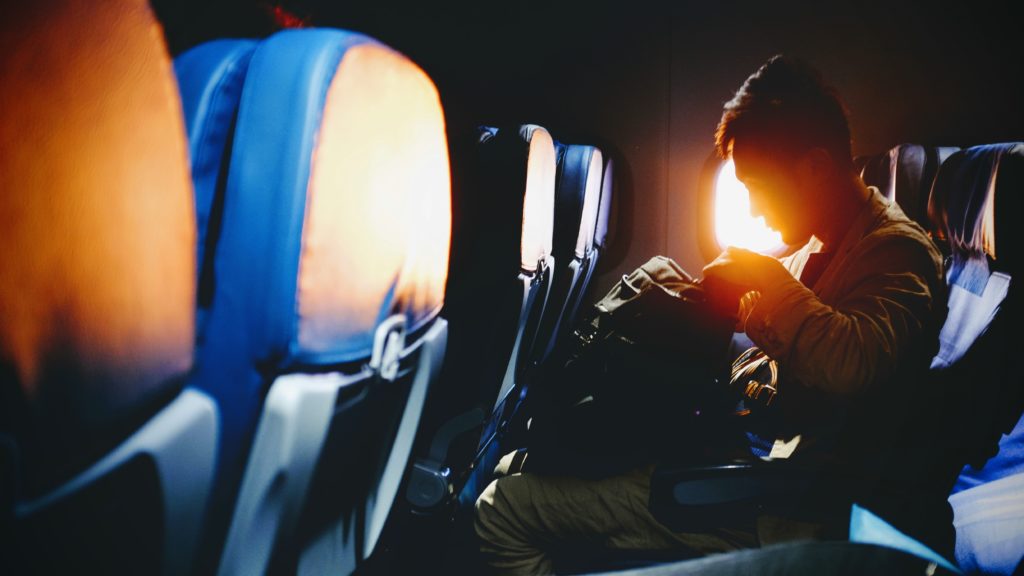All fields are required
Posted in Outbreaks & Recalls on August 16, 2018

I just returned from a marvelous and relaxing vacation to Mexico two days ago, and I am certain that I would have really benefited from the information that I am about to impart to you – Food Poisoning on Airplanes.
I actually enjoy flying, even the occasional turbulence that I equate to riding a roller coaster and that all-important “air time”. I’ve also never flown first class, and I have to admit to a bit of envy of those fliers with their roomy seats as I proceed to economy class where the seats seem to be designed as if people were chicken eggs stuffed in claustrophobic cartons. Riding in a metal projectile at 500 miles per hour is disconcerting, and we economy fliers look forward to a tiny bag of pretzels and half a can of Coke. Envy strikes again…those first classers are getting a tasty meal. But wait…
Going Number Two on a Plane
If you share the same reluctance as I do in going “number two” in public restrooms, imagine how difficult that is in the infinitesimally tiny confines of an airplane bathroom. Now take that one step further and imagine you have food poisoning (shudder). Frequent flier, travel consultant and blogger Ben Schlappig wrote about a colleague’s bout with “the runs”, euphemistically speaking, while on board a plane.
Nowadays, free meals you see on domestic flights are a thing of the past unless the flight takes more than three hours, and even that requirement differs from airline to airline. More frequently, we as passengers have to purchase meals or sandwiches that can be downright pricey. Ben Schlappig travels internationally on a frequent basis and had the misfortune of getting food poisoning not once but twice on international flights. Fortunately, his sickness wasn’t due to eating airline food (more on that later), but having to skillfully and gracefully navigate to the little closet the airlines call a restroom must’ve been harrowing. Schlappig decided that he would be proactive whenever he flew. The two products he found most effective in combating foodborne illnesses were activated charcoal and apple cider vinegar, and both are available in pill form. Activated charcoal has this amazing ability to bind with toxins in the body. The toxins get trapped in this super-absorbent material. Apple cider vinegar coats the gastrointestinal lining and kills bacteria. According to Schlappig, he felt better within a half hour after taking both of these remedies.
I’ll Take the Bottled Water and the Pretzels, Please
Airplane meals have a very short shelf life: a mere three hours, meaning that the pre-packaged perishables are loaded onto the aircraft while staff is preparing the flight for departure. If there’s an extended delay, all of that food has to be discarded. Meals are heated, not cooked, and they’re pretty much ready-to-go after they’re loaded onto the plane. Interestingly, when speeding through the clouds miles above the earth, the low pressure and dry air cause us to lose up to 30 percent of taste bud sensitivity. Salt anyone?
It’s actually pretty rare to contract a foodborne illness (especially Salmonella) from the food that is served on the plane because most of the food consists of pre-packaged snacks and as mentioned, meals have to be thrown out after three hours. The famous exception to this occurred in 1992 when many people were sickened with cholera after eating shrimp on a flight from Buenos Aires to Los Angeles. However, airline water can be contaminated with fecal matter, so it’s much better to ask for the bottled water.
But That’s Not the End of the Story for Food Poisoning on Airplanes
Many of us worry more about the quality of the air we breathe on a flight and all the supposed germs and viruses floating through the cabin. However, the air on a plane is actually quite clean, having been drawn into the aircraft and pressurized and passed through HEPA filters. The air is actually refreshed 20 times an hour. You need to worry more about the quarters you share with your cabin companions who are uncomfortably close and may be coughing and sneezing incessantly.
So, airplane air is the least of your worries. Do you know what a fomite is? They are inanimate objects that can carry and transmit bacteria. And they are everywhere on an aircraft: the tray table, seat arms, seat backs, armrests, the pocket that holds the safety brochure, pillows, and even the in-flight magazine can be rife with nasty germs. Shock factor alert: a 2007 study revealed that 60% of airplane tray tables contain Staphylococcus Auerus, or MRSA, a type of super-bug. Non-porous surfaces such as doorknobs, sliding metal locks, and seat belts can also harbor millions of bacteria and viruses. Certain bacteria and viruses can survive on these fomites from two days up to several months. Airline staff tries their best to clean in between flights, but in many cases the flight turnaround can be very brief, making it almost impossible to clean every surface. Currently there are no federal regulations that require the airlines to clean and disinfect tray tables, seats, or floors.
Plane Preparedness
Most of us probably never worry about the cleanliness of planes, but knowing this information has put me in a completely different state of mind. We wipe down our grocery cart handles, work desks, and our computer mouse and keyboard. Next time you board a flight, bring sanitizer and use it! Be more concerned with the tray table that your food is placed on rather than the food itself. You would be surprise what lurks there.
When flying:
I hope you stay safe and avoid Food Poisoning on Airplanes. And if you get sick, find your friendly neighborhood Salmonella lawyer.
By: Kerry Bazany, Contributing Writer (Non-Lawyer)